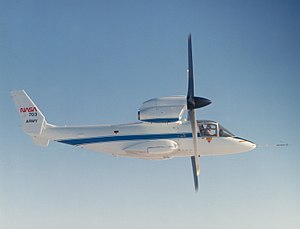Bell XV-15
| XV-15 | |
|---|---|
 |
|
| XV-15A in flight | |
| Role | Experimental VTOL aircraft |
| National origin | United States |
| Manufacturer | Bell Helicopter Textron |
| First flight | 3 May 1977 |
| Retired | 2003 |
| Primary user | NASA |
| Number built | 2 |
| Developed into | V-22 Osprey |
|
|
The Bell XV-15 was an American tiltrotor VTOL aircraft. It was the second successful experimental tiltrotor aircraft and the first to demonstrate the concept's high speed performance relative to conventional helicopters.
The idea of building Vertical Take-Off and Landing aircraft using helicopter-like rotors at the wingtips originated in the 1930s. The first design resembling modern tiltrotors was patented by George Lehberger in May 1930, but he did not develop the concept further. In World War II, a German prototype called the Focke-Achgelis FA-269 was developed starting in 1942, but it never flew.
Two prototypes that made it to flight were the one-seat Transcendental Model 1-G and two-seat Transcendental Model 2, both powered by single reciprocating engines. Development started on the Model 1-G in 1947, and it flew in 1954. The Model 1-G flew until a crash in Chesapeake Bay on 20 July 1955, destroying the prototype aircraft but not seriously injuring the pilot. The Transcendental 1-G was the first tiltrotor aircraft to have flown, and it accomplished most of a helicopter-to-aircraft transition in flight to within ten degrees of true horizontal aircraft flight. The Model 2 was developed and flew shortly afterward, but it did not fly much beyond hover tests. The United States Air Force withdrew funding in favor of the Bell XV-3.
The Bell XV-3 was first flown in 1955. Like its predecessors, the XV-3 had the engines in the fuselage and driveshafts transferring power out to tilting wingtip rotor assemblies.
Other rotor concepts, such as slowed rotors, stopped rotors, folding rotors, and variable-diameter rotors, were investigated for subsequent designs, but Bell engineers Kenneth Wernicke and Bob Lichten deemed them unfeasible compared to experience with the XV-3 project.
One of the major problems with the early tiltrotor aircraft designs was that the driveshafts carrying power from the fuselage out to the wingtip rotors, along with the gearbox and tilting mechanisms at the wingtips, had substantial loads placed upon them and were heavy. They were transferring large amounts of power and torque long distances for an aircraft power transmission system.
...
Wikipedia
